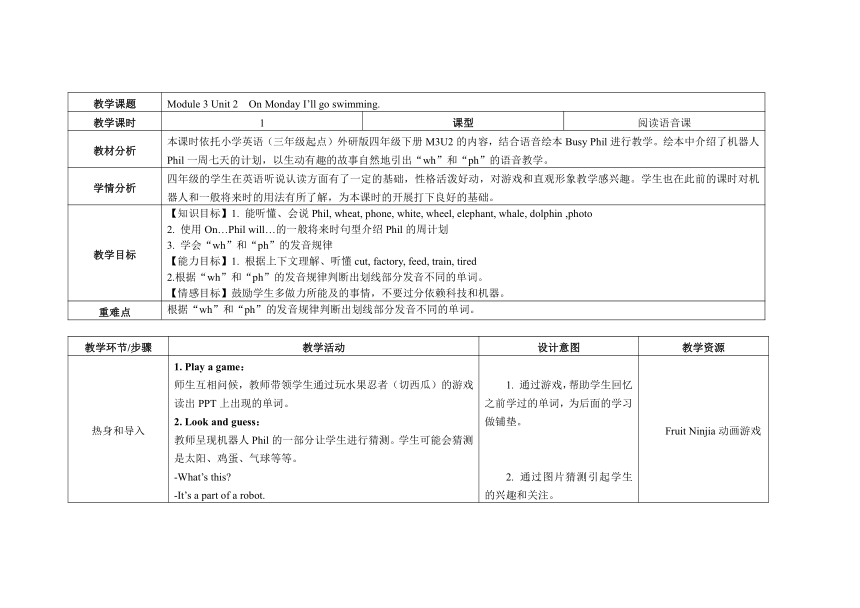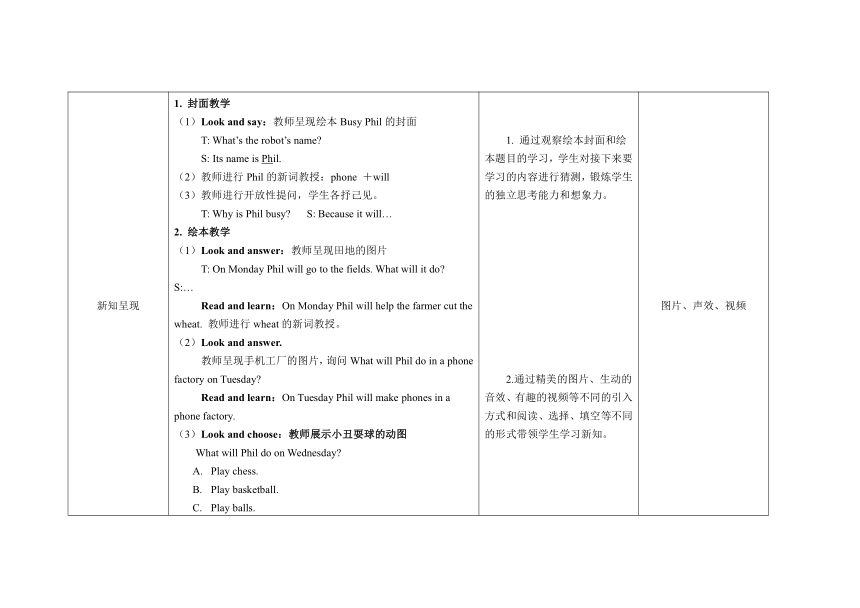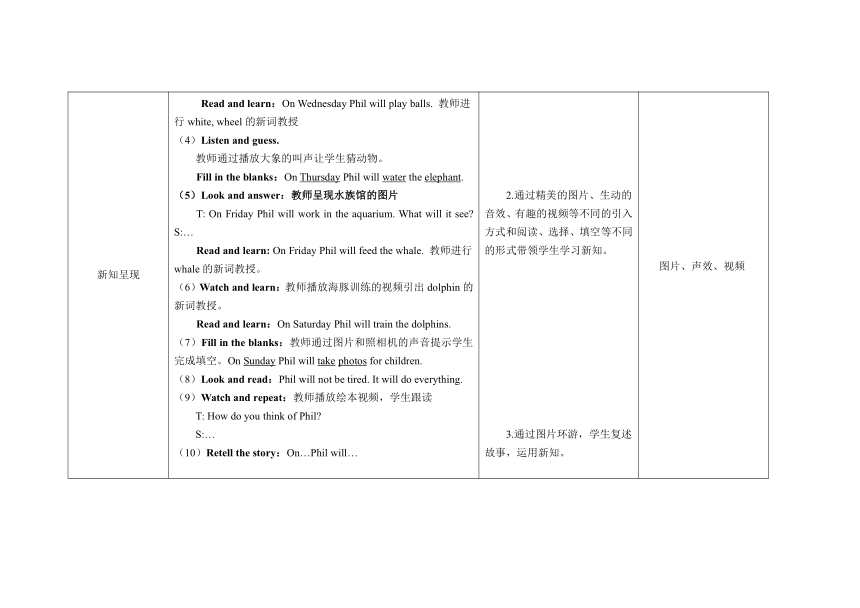Module 3 Unit 2 On Monday I'll go swimming 教案
文档属性
| 名称 | Module 3 Unit 2 On Monday I'll go swimming 教案 |

|
|
| 格式 | zip | ||
| 文件大小 | 3.6MB | ||
| 资源类型 | 教案 | ||
| 版本资源 | 外研版(三年级起点) | ||
| 科目 | 英语 | ||
| 更新时间 | 2021-03-08 12:39:59 | ||
图片预览



文档简介
教学课题
Module
3
Unit
2
On
Monday
I’ll
go
swimming.
教学课时
1
课型
阅读语音课
教材分析
本课时依托小学英语(三年级起点)外研版四年级下册M3U2的内容,结合语音绘本Busy
Phil进行教学。绘本中介绍了机器人Phil一周七天的计划,以生动有趣的故事自然地引出“wh”和“ph”的语音教学。
学情分析
四年级的学生在英语听说认读方面有了一定的基础,性格活泼好动,对游戏和直观形象教学感兴趣。学生也在此前的课时对机器人和一般将来时的用法有所了解,为本课时的开展打下良好的基础。
教学目标
【知识目标】1.
能听懂、会说Phil,
wheat,
phone,
white,
wheel,
elephant,
whale,
dolphin
,photo2.
使用On…Phil
will…的一般将来时句型介绍Phil的周计划3.
学会“wh”和“ph”的发音规律
【能力目标】1.
根据上下文理解、听懂cut,
factory,
feed,
train,
tired2.根据“wh”和“ph”的发音规律判断出划线部分发音不同的单词。【情感目标】鼓励学生多做力所能及的事情,不要过分依赖科技和机器。
重难点
根据“wh”和“ph”的发音规律判断出划线部分发音不同的单词。
教学环节/步骤
教学活动
设计意图
教学资源
热身和导入
1.
Play
a
game:师生互相问候,教师带领学生通过玩水果忍者(切西瓜)的游戏读出PPT上出现的单词。2.
Look
and
guess:教师呈现机器人Phil的一部分让学生进行猜测。学生可能会猜测是太阳、鸡蛋、气球等等。-What’s
this?-It’s
a
part
of
a
robot.
1.
通过游戏,帮助学生回忆之前学过的单词,为后面的学习做铺垫。2.
通过图片猜测引起学生的兴趣和关注。
Fruit
Ninjia动画游戏
新知呈现
1.
封面教学(1)Look
and
say:教师呈现绘本Busy
Phil的封面T:
What’s
the
robot’s
name?S:
Its
name
is
Phil.(2)教师进行Phil的新词教授:phone
+will(3)教师进行开放性提问,学生各抒己见。T:
Why
is
Phil
busy?
S:
Because
it
will…2.
绘本教学
(1)Look
and
answer:教师呈现田地的图片T:
On
Monday
Phil
will
go
to
the
fields.
What
will
it
do?
S:…Read
and
learn:On
Monday
Phil
will
help
the
farmer
cut
the
wheat.
教师进行wheat的新词教授。(2)Look
and
answer.教师呈现手机工厂的图片,询问What
will
Phil
do
in
a
phone
factory
on
Tuesday?Read
and
learn:On
Tuesday
Phil
will
make
phones
in
a
phone
factory.(3)Look
and
choose:教师展示小丑耍球的动图What
will
Phil
do
on
Wednesday?Play
chess.Play
basketball.Play
balls.Read
and
learn:On
Wednesday
Phil
will
play
balls.
教师进行white,
wheel的新词教授(4)Listen
and
guess.教师通过播放大象的叫声让学生猜动物。Fill
in
the
blanks:On
Thursday
Phil
will
water
the
elephant.
(5)Look
and
answer:教师呈现水族馆的图片T:
On
Friday
Phil
will
work
in
the
aquarium.
What
will
it
see?
S:…Read
and
learn:
On
Friday
Phil
will
feed
the
whale.
教师进行whale的新词教授。(6)Watch
and
learn:教师播放海豚训练的视频引出dolphin的新词教授。Read
and
learn:On
Saturday
Phil
will
train
the
dolphins.(7)Fill
in
the
blanks:教师通过图片和照相机的声音提示学生完成填空。On
Sunday
Phil
will
take
photos
for
children.(8)Look
and
read:Phil
will
not
be
tired.
It
will
do
everything.(9)Watch
and
repeat:教师播放绘本视频,学生跟读T:
How
do
you
think
of
Phil?S:…(10)Retell
the
story:On…Phil
will…
1.
通过观察绘本封面和绘本题目的学习,学生对接下来要学习的内容进行猜测,锻炼学生的独立思考能力和想象力。2.通过精美的图片、生动的音效、有趣的视频等不同的引入方式和阅读、选择、填空等不同的形式带领学生学习新知。2.通过精美的图片、生动的音效、有趣的视频等不同的引入方式和阅读、选择、填空等不同的形式带领学生学习新知。3.通过图片环游,学生复述故事,运用新知。
图片、声效、视频
训练和应用
语音教学(1)Watch
and
do:学生跟唱“wh”发音的视频并做动作。Look
and
find:根据新词找出“wh”发音规律。Let’s
learn:学习“wh”发音规律Play
a
game:
通过超级玛丽闯关游戏感知“wh”和
“w”发音的单词。Read
and
choose:
读一读,找出划线部分发音不同的单词。(2)Watch
and
do:学生跟唱“ph”发音的视频并做动作。Look
and
find:根据新词找出“ph”发音规律。Let’s
learn:学习“ph”发音规律Play
a
game:
通过开火车游戏感知“ph”和“f”发音的单词。Read
and
choose:
读一读,找出划线部分发音不同的单词。(3)Read
and
check:What
is
a
robot?阅读练习
1.视频可以通过大量的“wh”
and
“ph”的新词帮助学生总结它们的发音规律。2.游戏可以让学生在游乐中感知总结与“wh”
and
“ph”相同发音的字母。3.选择题则可以让学生更好地区分“wh”的两种不同发音。
1.“wh”和“ph”语音视频2.游戏3.活页练习题
总结
1.情感教育:
Robots
are
helpful.
Robots
can
do
everything.
What
can
you
do?
We
should
learn
more
skills,
and
do
what
we
can
do.
Do
not
rely(依赖)
on
robots
too
much.2.Watch
and
chant
1.鼓励学生多做力所能及的事情,不能懒惰和过于依赖机器。2.巩固复习“ph”
and
“wh”的发音规律。
视频
自我评价
1.
Read
loudly
声音响亮2.
Answer
the
questions
回答问题3.
Good
performance
表演投入4.
Good
pronunciation
发音标准5.
Good
cooperation
良好合作
让学生进行自我评价,总结自我表现,找出往后努力方向。
表格
作业布置
1.Watch
a
book
or
a
film
about
robots.2.
Find,
write
down
and
read
more
words
with
the
letters
“ph”
and
“wh”.
让学生了解更多关于机器人的知识以及巩固“ph”
and
“wh”的发音学习。
PPT
板书设计
Module
3
Unit
2
On
Monday
I’ll
go
swimming.
新知呈现
图片、声效、视频
wheel
take
photos
cut
the
wheat
water
the
elephant
feed
the
whale
train
the
dolphins
play
balls
On…Phil
will...
make
phones
Module
3
Unit
2
On
Monday
I’ll
go
swimming.
教学课时
1
课型
阅读语音课
教材分析
本课时依托小学英语(三年级起点)外研版四年级下册M3U2的内容,结合语音绘本Busy
Phil进行教学。绘本中介绍了机器人Phil一周七天的计划,以生动有趣的故事自然地引出“wh”和“ph”的语音教学。
学情分析
四年级的学生在英语听说认读方面有了一定的基础,性格活泼好动,对游戏和直观形象教学感兴趣。学生也在此前的课时对机器人和一般将来时的用法有所了解,为本课时的开展打下良好的基础。
教学目标
【知识目标】1.
能听懂、会说Phil,
wheat,
phone,
white,
wheel,
elephant,
whale,
dolphin
,photo2.
使用On…Phil
will…的一般将来时句型介绍Phil的周计划3.
学会“wh”和“ph”的发音规律
【能力目标】1.
根据上下文理解、听懂cut,
factory,
feed,
train,
tired2.根据“wh”和“ph”的发音规律判断出划线部分发音不同的单词。【情感目标】鼓励学生多做力所能及的事情,不要过分依赖科技和机器。
重难点
根据“wh”和“ph”的发音规律判断出划线部分发音不同的单词。
教学环节/步骤
教学活动
设计意图
教学资源
热身和导入
1.
Play
a
game:师生互相问候,教师带领学生通过玩水果忍者(切西瓜)的游戏读出PPT上出现的单词。2.
Look
and
guess:教师呈现机器人Phil的一部分让学生进行猜测。学生可能会猜测是太阳、鸡蛋、气球等等。-What’s
this?-It’s
a
part
of
a
robot.
1.
通过游戏,帮助学生回忆之前学过的单词,为后面的学习做铺垫。2.
通过图片猜测引起学生的兴趣和关注。
Fruit
Ninjia动画游戏
新知呈现
1.
封面教学(1)Look
and
say:教师呈现绘本Busy
Phil的封面T:
What’s
the
robot’s
name?S:
Its
name
is
Phil.(2)教师进行Phil的新词教授:phone
+will(3)教师进行开放性提问,学生各抒己见。T:
Why
is
Phil
busy?
S:
Because
it
will…2.
绘本教学
(1)Look
and
answer:教师呈现田地的图片T:
On
Monday
Phil
will
go
to
the
fields.
What
will
it
do?
S:…Read
and
learn:On
Monday
Phil
will
help
the
farmer
cut
the
wheat.
教师进行wheat的新词教授。(2)Look
and
answer.教师呈现手机工厂的图片,询问What
will
Phil
do
in
a
phone
factory
on
Tuesday?Read
and
learn:On
Tuesday
Phil
will
make
phones
in
a
phone
factory.(3)Look
and
choose:教师展示小丑耍球的动图What
will
Phil
do
on
Wednesday?Play
chess.Play
basketball.Play
balls.Read
and
learn:On
Wednesday
Phil
will
play
balls.
教师进行white,
wheel的新词教授(4)Listen
and
guess.教师通过播放大象的叫声让学生猜动物。Fill
in
the
blanks:On
Thursday
Phil
will
water
the
elephant.
(5)Look
and
answer:教师呈现水族馆的图片T:
On
Friday
Phil
will
work
in
the
aquarium.
What
will
it
see?
S:…Read
and
learn:
On
Friday
Phil
will
feed
the
whale.
教师进行whale的新词教授。(6)Watch
and
learn:教师播放海豚训练的视频引出dolphin的新词教授。Read
and
learn:On
Saturday
Phil
will
train
the
dolphins.(7)Fill
in
the
blanks:教师通过图片和照相机的声音提示学生完成填空。On
Sunday
Phil
will
take
photos
for
children.(8)Look
and
read:Phil
will
not
be
tired.
It
will
do
everything.(9)Watch
and
repeat:教师播放绘本视频,学生跟读T:
How
do
you
think
of
Phil?S:…(10)Retell
the
story:On…Phil
will…
1.
通过观察绘本封面和绘本题目的学习,学生对接下来要学习的内容进行猜测,锻炼学生的独立思考能力和想象力。2.通过精美的图片、生动的音效、有趣的视频等不同的引入方式和阅读、选择、填空等不同的形式带领学生学习新知。2.通过精美的图片、生动的音效、有趣的视频等不同的引入方式和阅读、选择、填空等不同的形式带领学生学习新知。3.通过图片环游,学生复述故事,运用新知。
图片、声效、视频
训练和应用
语音教学(1)Watch
and
do:学生跟唱“wh”发音的视频并做动作。Look
and
find:根据新词找出“wh”发音规律。Let’s
learn:学习“wh”发音规律Play
a
game:
通过超级玛丽闯关游戏感知“wh”和
“w”发音的单词。Read
and
choose:
读一读,找出划线部分发音不同的单词。(2)Watch
and
do:学生跟唱“ph”发音的视频并做动作。Look
and
find:根据新词找出“ph”发音规律。Let’s
learn:学习“ph”发音规律Play
a
game:
通过开火车游戏感知“ph”和“f”发音的单词。Read
and
choose:
读一读,找出划线部分发音不同的单词。(3)Read
and
check:What
is
a
robot?阅读练习
1.视频可以通过大量的“wh”
and
“ph”的新词帮助学生总结它们的发音规律。2.游戏可以让学生在游乐中感知总结与“wh”
and
“ph”相同发音的字母。3.选择题则可以让学生更好地区分“wh”的两种不同发音。
1.“wh”和“ph”语音视频2.游戏3.活页练习题
总结
1.情感教育:
Robots
are
helpful.
Robots
can
do
everything.
What
can
you
do?
We
should
learn
more
skills,
and
do
what
we
can
do.
Do
not
rely(依赖)
on
robots
too
much.2.Watch
and
chant
1.鼓励学生多做力所能及的事情,不能懒惰和过于依赖机器。2.巩固复习“ph”
and
“wh”的发音规律。
视频
自我评价
1.
Read
loudly
声音响亮2.
Answer
the
questions
回答问题3.
Good
performance
表演投入4.
Good
pronunciation
发音标准5.
Good
cooperation
良好合作
让学生进行自我评价,总结自我表现,找出往后努力方向。
表格
作业布置
1.Watch
a
book
or
a
film
about
robots.2.
Find,
write
down
and
read
more
words
with
the
letters
“ph”
and
“wh”.
让学生了解更多关于机器人的知识以及巩固“ph”
and
“wh”的发音学习。
PPT
板书设计
Module
3
Unit
2
On
Monday
I’ll
go
swimming.
新知呈现
图片、声效、视频
wheel
take
photos
cut
the
wheat
water
the
elephant
feed
the
whale
train
the
dolphins
play
balls
On…Phil
will...
make
phones
同课章节目录
- Module 1
- Unit 1 She's a nice teache
- Unit 2 He's cool.
- Module 2
- Unit 1 London is a big city.
- Unit 2 It's very old.
- Module 3
- Unit 1 Robots will do everything.
- Unit 2 On Monday I'll go swimming.
- Module 4
- Unit 1 Will you take your kite?
- Unit 2 Will it be hot in Haikou?
- Module 5
- Unit 1 I was two then.
- Unit 2 They were young.
- Module 6
- Unit 1 Were you at home yesterday?
- Unit 2 Was it a big city then ?
- Module 7
- Unit 1 I helped Mum.
- Unit 2 Grandma cooked fish.
- Module 8
- Unit 1 They sang beautifully.
- Unit 2 I took some pictures.
- Module 9
- Unit 1 Did he live in New York ?
- Unit 2 Did you have a nice holiday?
- Review Module
- Unit 1
- Unit 2
- Module 10
- Unit 1 Did you fall off your bike?
- Unit 2 Sam had lots of chocolate.
